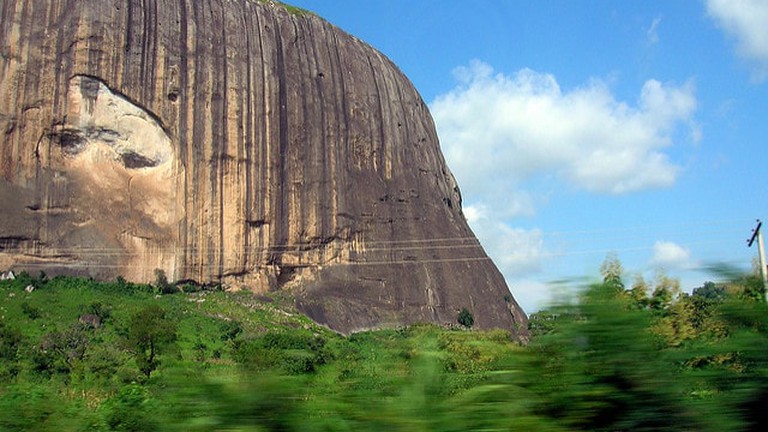Nigeria is a nation blessed with an abundance of natural landmarks. The Olumo Rock, Ikogosi warm water Spring, Zuma Rock, Gurara Falls, Owu Falls, Erin Ijesha Waterfalls and Ogbunike Caves are some of the major landmarks in Nigeria.
Today, we would be talking about the magnificent Zuma Rock. The iconic image of the Rock can be found on the 100 Naira bill representing the significance of the rock as a natural heritage site in Nigeria. It is a located in Madalla, Niger State, to the North of Abuja. People who grew up in the North would have heard numerous tales about this huge rock.
Zuma Rock was once described as the unquestionable watchman of the Federal Capital Territory. It is a great tourist center attracting numerous tourists every year. Behind the Rock is the Zuma Rock Village, which was built to accommodate tourists visiting the Rock.
Although located in Niger State, it has over time become a significant symbol of Abuja’s landscape, due to its proximity to Abuja City.
Geologically, Zuma Rock is a monolith – which is a large single upright block of stone, especially one shaped into or serving as a pillar or monument. It stands at 725 meters (2,376 ft) above ground level and has a circumference of 3.1 kilometers.
Historically, it was first discovered in a thick forest by the people of Zuba and the Koro in the 15th century when they settled around the rock which was initially called ‘Zumwa’, meaning, ‘the place where Guinea Fowls are caught’. The Zuba and Koro people settled within a mile radius around it. Over time, it has served as the protection fort for the communities around it.
As expected with great historical sites, Zuma Rock has a lot of myths and beliefs surrounding it. We will explore some of them.
It has a human face, Yes, you read right! this is probably the most popular feature and myth of the Rock. Zuma Rock has natural contours on the surface which depict the image of a human face with a visible mouth, eyes, and nose. The natives of the community believe the face represents the deity and ancestral powers protecting and governing the affairs of the communities around it.
The Rock ignites during the rainy season, the tip of the Rock burst into flames during the rainy season. The indigenes believe that the Rock’s deity creates the flames; however, scientists think otherwise, Dr. Kistso Ngargbu, a geologist and lecturer at Nassarawa State University, Keffi, explained that the fire is caused by boulders and small pieces of rock gliding against each other. A boulder is a large rock, typically one that has been worn smooth by erosion. When the rainwater gets to surface of the rock, it lubricates the boulder, causing it to slide down the sloppy surface, this causes friction between the boulder and the rock creating the fire. This can be likened to striking two stones against each other to make a fire, which was how fires were made in time past.
The other mountains around Zuma Rock worship it, there are no rocks or mountains located around the Zuma Rock and the natives see this as a form of respect being paid by the other mountains to Zuma Rock for its royal presence in the locality.
The Rock sits on an underground body of water, natives believe that the rock sits on a very large source of underground water.
To see the much-talked-about Zuma Rock Fires, visit between April and October, which marks the rainy season in Central/Northern Nigeria.
Planning to visit Abuja for leisure? Then the Zuma Rock is a must see. We are waiting for pictures.

